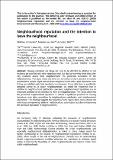Files in this item
Neighbourhood reputation and the intention to leave the neighbourhood
Item metadata
| dc.contributor.author | Permentier, Matthieu | |
| dc.contributor.author | Van Ham, Maarten | |
| dc.contributor.author | Bolt, Gideon | |
| dc.date.accessioned | 2016-01-06T15:40:06Z | |
| dc.date.available | 2016-01-06T15:40:06Z | |
| dc.date.issued | 2009-09 | |
| dc.identifier | 2109354 | |
| dc.identifier | 0762c158-d96e-477d-a545-01c596eaea68 | |
| dc.identifier | 000270524700009 | |
| dc.identifier | 70350554154 | |
| dc.identifier.citation | Permentier , M , Van Ham , M & Bolt , G 2009 , ' Neighbourhood reputation and the intention to leave the neighbourhood ' , Environment and Planning A , vol. 41 , no. 9 , pp. 2162-2180 . https://doi.org/10.1068/a41262 | en |
| dc.identifier.issn | 0308-518X | |
| dc.identifier.other | ORCID: /0000-0002-2106-0702/work/64697503 | |
| dc.identifier.uri | https://hdl.handle.net/10023/7980 | |
| dc.description.abstract | Moving intentions are likely to be affected not only by whether or not residents are satisfied with their neighbourhood, but also by how they think that other city residents assess their neighbourhood: the perceived reputation of the neighbourhood. The place where one lives is a reflection of one's position in society and therefore people may want to leave neighbourhoods with a poor reputation even if they are satisfied with their residential environment. Using data from a specifically designed survey in twenty-four Dutch neighbourhoods we tested the hypothesis that, in addition to neighbourhood satisfaction, perceived neighbourhood reputations are an important predictor of the intention to leave a neighbourhood. The results show that perceived neighbourhood reputation is indeed a significant predictor of moving intentions, even after controlling for neighbourhood satisfaction and neighbourhood attachment. This finding suggests that neighbourhood regeneration policy should focus not only on improving residents' neighbourhood satisfaction, but also on improving the perceived reputation of neighbourhoods. | |
| dc.format.extent | 19 | |
| dc.format.extent | 394776 | |
| dc.language.iso | eng | |
| dc.relation.ispartof | Environment and Planning A | en |
| dc.subject | Residential-mobility | en |
| dc.subject | Housing estates | en |
| dc.subject | Social cohesion | en |
| dc.subject | Netherlands | en |
| dc.subject | Context | en |
| dc.subject | Segregation | en |
| dc.subject | Utrecht | en |
| dc.subject | Poverty | en |
| dc.subject | Blacks | en |
| dc.subject | Stigma | en |
| dc.subject | H Social Sciences (General) | en |
| dc.subject.lcc | H1 | en |
| dc.title | Neighbourhood reputation and the intention to leave the neighbourhood | en |
| dc.type | Journal article | en |
| dc.contributor.institution | University of St Andrews. Geography & Sustainable Development | en |
| dc.contributor.institution | University of St Andrews. School of Geography and Geosciences | en |
| dc.identifier.doi | 10.1068/a41262 | |
| dc.description.status | Peer reviewed | en |
This item appears in the following Collection(s)
Items in the St Andrews Research Repository are protected by copyright, with all rights reserved, unless otherwise indicated.

